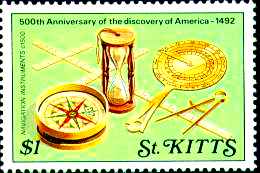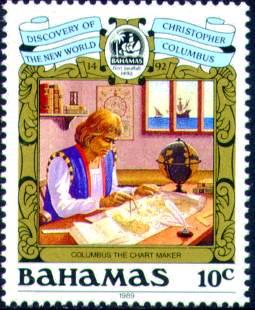|

|
Maritime Topics On Stamps :
A little guide for the thematic collector!
|
Everybody can collect what he wants to and how he wants to. Everyone
can buy inlays and albums, develop special pages by himself or simply
stow the stamps away in boxes. But if you want to show your collection
at an exhibition you have to adhere to certain rules and restrictions.
The rules help the jury to compare and judge the entries for the
exhibition.To stay competitive you have to know
and accept tenor and procedures of such a philatelistic event,
including its weaknesses.
Here are a few hints:
- General:
- Selecting a good theme is pretty straightforward, the first draft of the
structure can take a few weeks, but a good collection will problably take years!
- First choose a theme and make a rough arrange, then start to collect, then sort your
results, then develop a plan how to set up your show exactly. After everything
has been arranged you can actually start building your show.
- Theme and goal:
- Search for a theme which is likely to generate interest
and curiosity within the spectator.
- Likewise the theme should be interesting for you as well. Not just from a collector's point of view.
- Is this theme suitable for a philatelic thematic collection?
- You should research the background for the theme in advance.
- The theme should have a unique touch to differentiate from most standard collections.
- Avoid narrowness to be able to collect enough philatelistic material.
- Define your theme precisely. The theme should have a clearly defined start and end, maybe
utilize a timeline.
You should add a personal note by adding something special or unusual to the basic theme.
- Building the basis of your theme by acquiring suitable material:
- Trade, buy, or search in turnaround services of a club;
- Check out dealers, auctions, conventions or fairs;
- Search professional magazines.
- Note: Don't collect everything you can get your hands on and which somehow seems to fit from the first day on.
Start by selecting a very limited field, the expansion into other fields will happen automatically during the collection process.
Limit yourself! You don't need ten stamps of the same motive.
- You can use every philatelistic note which is roughly connected to the theme.
This includes postage stamps, stamp booklets, stamp marks, covers, postal
stationary, Aerogramme, free official letters, postcards, post forms etc.
- The motive should always be in the foreground. Consequently original gum stamps always
have an advantage compared to cancelled stamps. The cancellation should not cover the motive.
You should decide on using gum stamps or cancelled stamps right at the beginning.
- If you want to have a mix of stamps, then don't mix on the same page.
- Ships on stamps of e.g. 'Bhutan' are less authentic than on stamps of e.g.
'Portugal'.
- Correctly stamped mailings are preferred.
- Multiples of the same stamp are better than a mix of stamps.
- You do not need complete sets.
- Keep in mind: Post marks with motives enrich every collection.
- A correctly postaged running letter is better than a letter with non-official
post marks.
- Suitable motive prints on private entires will be rejected by the judges.
- The judges must be able to recognize the theme in the postal information.
- Contradictions in the material score bad marks, i.e. stamp and post mark on one
entire must always be fitting.
- The whole material must have been prepared for correct postal transmission.
- You should have some 'stars' in you collection.
- Acquiring basic knowledge:
- Motive knowledge and philately are basic requirements.
- Basic knowledge should be extended by research using
- professional literature,
- special catalogs,
- tips and consulting by experienced collectors, philatelistic clubs and
working groups, and
- visits to exhibitions, conventions and museums.

- Building the collection, making a plan, develop categories and structure:
- Choose a title, not too simple, but no bragging as well. The title must be comprehensible
and fitting for the theme. The title and the object of your collection must match as well!
- Make a plan and develop a structure. This plan has to appear at the beginning
of the collection.
- Everyone should be recoginzable as your own. No cheap copies of other collections.
- The structure should divide into main sections and chapters. A seperation using
the decimal system (1.1. 1.2. etc.) is recommended.
- Every section must be oriented towards the main theme.
- All sections should be roughly the same size (approximately 2 to 3 pages). Not one short section
followed by a long section, followed by a short one again, etc.
- If you are using a timeline the sequence of the pages should follow a chronological order.
- Layout, Size, Composition:
- Sort your material in accordance to the sections of your structure.
- Use European DIN A4 format pages, as theses are likely to become prescribed
for all exhibitions in the near future! International events already are using
exclusively DIN A4.
- Page count must be a multiple of 16 (12 in Germany) including title page and
structure, because 16 (12) is the maximum number of pages which will fit
into a frame.
- Total frame count normally ranges between six and seven.
- All pages should be in protective covers.
- Visual impression is very important: Pages can have borders or not, but
appearance should be consistent throughout all pages. A frame is a good border
but you can use headers and footers for top and bottom borders as well. Side
borders can be 'built' using voucher frames or blocks.
- Using white paper for pages is recommended. Coloured pages can easily become OOP (out
of production) and hard to get. Always use cardboard and go for the heavier volumes.
- All pages should be numbered and bear a notice, mark or sign referencing your overall
structure.
- A footer is always the end of a page.
- Tip: Create a template for your page and copy it.
- A themed collection should carry only themed texts. If you want to add
philatelistic notes, keep them very brief.
- Try to do your texts by computer or a typewriter, size 12-14 dots or 2-3 mm.
- Don't clog your collection with too much text. Less is more!
- Don't use too much professional terms.
- Don't put too much material on one page, but refrain from single items as well.
- When arranging your material on a page, try to mix stamps and covers.
- For improved looks you should arrange the great covers at the bottom of the
page and the smaller ones to the top.
- Old and new material are better located on separate pages.
Let's go!
|
|